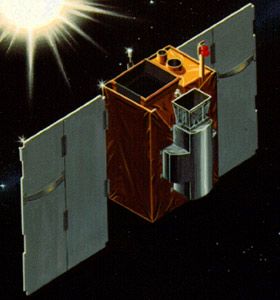
Home - Search - Browse - Alphabetic Index: 0- 1- 2- 3- 4- 5- 6- 7- 8- 9
A- B- C- D- E- F- G- H- I- J- K- L- M- N- O- P- Q- R- S- T- U- V- W- X- Y- Z
SAMPEX
 SAMPEX Credit: Manufacturer Image |
AKA: Solar Anomalous and Magnetospheric Particle Explorer. Status: Operational 1992. First Launch: 1992-07-03. Last Launch: 1992-07-03. Number: 1 . Gross mass: 158 kg (348 lb). Height: 1.50 m (4.90 ft).
SAMPEX was designed to study the energy, composition and charge states of four classes of charged particles that originated beyond the Earth: (1) galactic cosmic rays (from supernova explosions in the Milky Way Galaxy); (2) anomalous cosmic rays (from the interstellar gas surrounding our solar system); (3) solar energetic particles (from explosions in the solar atmosphere); and (4) magnetospheric electrons (particles from the solar wind trapped by the Earth's magnetic field).
SAMPEX was the first of NASA's Small Explorer (SMEX) missions. SAMPEX observations were designed to provide new information on the cosmic abundances of elements and their isotopes, the composition of local interstellar gas, the solar composition and the mechanisms responsible for solar atmospheric heating, and electron energy injection into the Earth's upper atmosphere.
The single string architecture satellite used a momentum-bias control system with 1 momentum wheel and 3 torque rods for vehicle pointing. Attitude knowledge was better than 2 deg (3 sigma). Attitude sensing was via sun sensors, star sensors, and a magnetometer. Two deployable, articulated solar panels with GaAs cells provided 102 W orbit average power (no eclipse) and recharged one 9 A-hr NiCd battery. The aluminum structure bus used passive thermal control. Two omni antennas and near-Earth 5 W S-band transponders provided communications. The payload used solid-state memory and a fiber optic Mil-Std 1773 data bus.
SAMPEX carried 4 instruments:
- HILT (Heavy Ion Large Area Proportional Counter Telescope) measured heavy ions from 8 to 220 MeV/nucleon for oxygen.
- LEICA (Low Energy Ion Composition Analyzer) measured 0.5 to 5 MeV for solar and magnetospheric ions. LEICA and HILT were originally designed and constructed as Get-Away-Specials for shuttle flight.
- MAST (Mass Spectrometer Telescope) measured isotropic composition of elements from Li to Ni in the range of 10 MeV to several hundred MeV.
- PET (Proton/Electron Telescope) complemented MAST by measuring the energy spectra and relative composition of protons (18 to 250 MeV) and helium nuclei (18 to 350 MeV/nuclei) of solar, interplanetary, and galactic origins, and the energy spectra of solar flare and precipitating electrons from 0.4 to 30 MeV.
NASA NSSDC Master Catalog Description
The Solar Anomalous and Magnetospheric Particle Explorer (SAMPEX) is the first of a series of spacecraft that was launched under the Small Explorer (SMEX) mission of program for low cost spacecraft. The main objectives of SAMPEX experiments was to obtained data for several continuous years on the anomalous components of cosmic rays, on solar energetic particles emissions from the sun, and on the precipitating magnetospheric relativistic electrons. The orbit of SAMPEX has an altitude of 512 by 687 km and an 81.7 degree inclination. The spacecraft uses an on-board 3-axis stabilized solar pointed/momentum bias system with the pitch axis pointed to towards the sun. Solar panels provide power for operations, including 16.7 W for science instruments. An on-board DPU preprocesses the science and other data and stores them in a RPP unit of about 65 Mb, before transmitting in the S-band at a rate of 1.5 Mb/s over Wallops (or a back-up) station. The command memory can store at least a thousand commands. The science instruments generally point toward local zenith, especially over the terrestrial poles, for optimal sampling of galactic and solar cosmic ray flux. Energetic magnetospheric particle precipitation is monitored at lower geomagnetic latitudes. It carries four science instruments: (1) low energy ion composition analyzer (LICA); (2) heavy ion large telescope (HILT); (3) mass spectrometer telescope (MAST); and (4) proton electron telescope (PET). Estimated useful lifetime of the spacecraft was about three years; however, the data stream continue to July, 2004. In 1997, NASA Goddard transferred operation of SAMPEX to the Flight Dynamics and Control Laboratory (FDCL) housed within the Aerospace Engineering Department of the University of Maryland. For more details, see IEEE Transactions on Geoscience and Remote Sensing (Vol 31, Issue 3, May 1993, pp. 531-574). The spacecraft re-entered the atmosphere on Nov. 13, 2012.
More at: SAMPEX.
Family: Earth, Magnetosphere sat, Medium earth orbit. Country: USA. Launch Vehicles: Scout, Scout G-1. Projects: Small Explorer. Launch Sites: Vandenberg, Vandenberg SLC5. Agency: NASA, NASA Greenbelt. Bibliography: 2, 279, 6, 6853, 13057.
1992 July 3 - . 14:19 GMT - . Launch Site: Vandenberg. Launch Complex: Vandenberg SLC5. LV Family: Scout. Launch Vehicle: Scout G-1.
- SAMPEX - . Mass: 158 kg (348 lb). Nation: USA. Agency: NASA Greenbelt. Program: Small Explorer. Class: Earth. Type: Magnetosphere satellite. Spacecraft: SAMPEX. Decay Date: 2012-11-13 . USAF Sat Cat: 22012 . COSPAR: 1992-038A. Apogee: 670 km (410 mi). Perigee: 506 km (314 mi). Inclination: 81.70 deg. Period: 96.50 min. First Small Explorer mission; Solar Anomalous and Magnetospheric Particle Explorer. Spacecraft engaged in research and exploration of the upper atmosphere or outer space (US Cat B)..
Back to top of page
Home - Search - Browse - Alphabetic Index: 0- 1- 2- 3- 4- 5- 6- 7- 8- 9
A- B- C- D- E- F- G- H- I- J- K- L- M- N- O- P- Q- R- S- T- U- V- W- X- Y- Z
© 1997-2019 Mark Wade - Contact
© / Conditions for Use